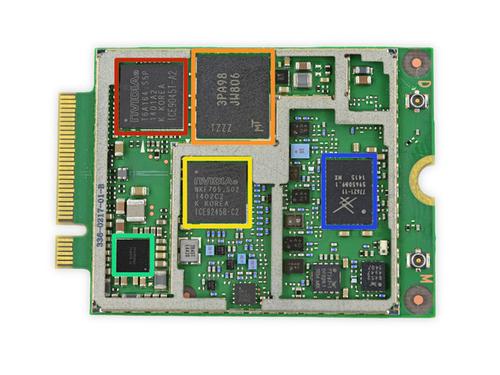ah ok, but will it be ready for Q3 ?I was talking about the Snapdragon 810 not the 410.
I read somewhere that 810 won't be in devices before Q1 2015
Follow along with the video below to see how to install our site as a web app on your home screen.
Note: This feature may not be available in some browsers.
ah ok, but will it be ready for Q3 ?I was talking about the Snapdragon 810 not the 410.
They can but they don't have to, and when it comes to SoC specific stuff they generally don't.
Sure. You have things like Ubuntu announcing support for POWER8 and ARM versions of Debian and Ubuntu though, but the former is not SoC related and most often the disk images or such are provided "unofficial". The unofficial stuff can be well good enough I think.
I am now having doubts that the Nexus 9 will even have a Nvidia SOC.
With the HTC Desire 510 containing the "Qualcomm’s first 64-bit chip – the 1.2GHz Snapdragon 410" why would HTC ditch Qualcomm for the Nexus 9. Why not just use the Snapdragon 810.
http://www.forbes.com/sites/gordonkelly/2014/08/27/iphone-6-ipad-nexus-android-rival
The whole premise that Nvidia was going to win the Nexus 9 was that it was going to be an ARM 64bit SOC and many thought that only Nvidia would have a 64bit ARM SOC available in the time frame. It now looks like Qualcomm is also going to be available.
Snapdragon 810 is still sampling and is expected to be in devices that are shipped during the first half of 2015.
That logic didn't stop Google from going with the Snapdragon S4 Pro instead of the Tegra 4 in the Nexus 7 2013.Even then, the expectation is that the single-threaded CPU performance and the GPU performance of TK1-Denver will be even better than S810.
Well if the 410 (Cortex A53) is going to be available soon what reason is there that the 810 (Cortex A57) would not be far behind?
Well if the 410 (Cortex A53) is going to be available soon what reason is there that the 810 (Cortex A57) would not be far behind?
That logic didn't stop Google from going with the Snapdragon S4 Pro instead of the Tegra 4 in the Nexus 7 2013.
Cost also matters and QualComm has been known to undercut competitors on price just to keep them from gaining market share.
Because 410 is made on TSMC 28LP (probably over 28HPm for cost reasons) and 810 is going to be on TSMC 20SoC.
TNW: Are there any lesser-known leakers out there with the potential to step into your shoes?
EB: Someone who is immediately springs to mind is TK O’Connor, of TK Tech News. The man is a beast when it comes to leaking — and body checks — but he’s also the nicest guy you’ll ever meet.
Even that CPU Architecture says "192-core Kepler" ?Everything but the revision number in that CPU-Z seems to be spot on.
Even that CPU Architecture says "192-core Kepler" ?
there are a lot of discrepancies on that screen shot I would try to check them out because this sounds a bit fishy! CPU Architecture is not 192 Core Kepler, Its ARMv8 and GPU Renderer should not mention Denver because that's the CPU that's where it should say 192 Core Kepler!
https://www.youtube.com/watch?v=7W_utZdw5RY&feature=youtu.be
He's not just linking to a video he didn't make. He took the screenshot and claims he's had the tablet in his hand and ran all kinds of benchmarks in it, which he's going to share when he leaves China and doesn't need to pay enormous amounts of roaming charges.
The HTC "Flounder" has been rumoured to be carrying TK1 Denver. Everything but the revision number in that CPU-Z seems to be spot on. The revision may not be in the CPU's microcode and it could be something that the CPU-Z doesn't read but just "assumes" as being a 32bit TK1 variant.
no.could NV be using the r3p3 for optimum code paths for applications?
could NV be using the r3p3 for optimum code paths for applications?
Not saying the "leak" is real, but just like setting an AMD chip to be an intel chip so ICC code takes AVX/SSE3/4 etc path instead of SSE2.
Google's Project Tango Tablet: From the Outside InNVIDIA NB106-N
- Manufacturer:
- NVIDIA
- Device Type:
- Chipset / Module - NGFF
- Network Type:
- LTE / GPRS / EDGE / HSDPA 3.6 / HSDPA 7.2 / HSPA+ 14.4 / HSPA+ 21.1 / LTE CAT1 / LTE CAT2 / LTE CAT3
- Release Date:
- Q2-2014
- Description:
- The NVIDIA NB106-N is certified for use on the AT&T Network.
http://developer.att.com/developer/device_detail.jsp?id=f001f100-6dce-439f-953f-bb5b17a865b5
Notable ICs on the baseband module:
- Nvidia ICE9245B-C2 low-power, multi-mode RF transceiver (red)
- Micron 3PA98 JW806 NAND-based MCP (orange)
- Nvidia Icera ICE9045T-A2 LTE Modem (yellow)
- Texas Instruments TPS659121A PMU for Processor Power (green)
- Skyworks 77621-11 Multimode Multiband Power Amplifier Module (blue)
http://www.designnews.com/author.as...umer,aid_274501&doc_id=274501&image_number=21

